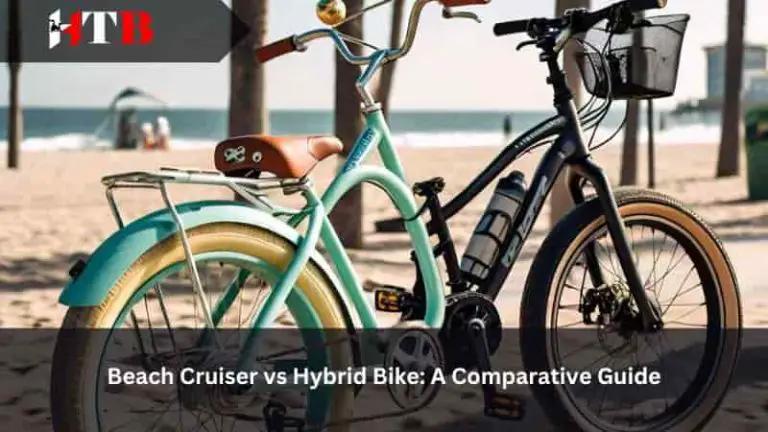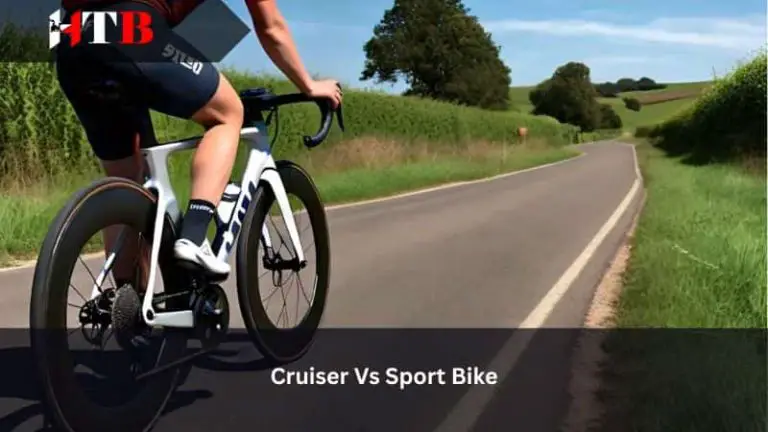Mountain Bike vs Cruiser Bike: Key Differences Explained
As you delve into this comparative exploration of mountain bikes versus cruisers, you’ll uncover not just specifications but also lifestyles that influence your choice on two wheels.
Whether you thrive on adrenaline-fueled climbs or prefer leisurely rides through picturesque parks, understanding these differences can help you make an informed decision about which bike suits your spirit best.
Buckle up as we journey through terrain types, riding styles, and personal preferences to find out whether you’re more likely to tackle wild landscapes or take a serene spin around town!
Mountain Bike vs Cruiser
Key Differences
Mountain bikes stand out for their off-road capabilities. They have a rugged frame geometry that positions riders for better control on uneven surfaces. Their tires feature deep treads for grip on dirt and mud. In contrast, cruisers flaunt a laid-back frame design, ideal for upright riding on smooth paths. Their cruiser bike tires are wider with a balloon-like structure to cushion the ride, a way hybrid bikes enhance riding comfort.
Mountain bikes often come with multiple gears to tackle steep inclines and rough terrain. They also boast advanced brake systems like disc brakes for reliable stopping power in all conditions, making hybrid bikes and cruiser bikes ideal for riding and exercise. Cruisers typically sport single-speed or limited gearing and use simpler coaster brakes, emphasizing ease over versatility.
Purpose: Mountain Bike vs Cruiser
Mountain bikes are designed for conquering challenging terrains and embarking on outdoor adventures. They cater to those seeking an adrenaline rush or wanting to navigate through nature’s obstacles. On the other hand, cruiser bikes invite riders to enjoy comfort and leisurely rides. They’re perfect for casual outings around town or along beachfront promenades on your cruiser bike, doubling as exercise.
The physical demand and skill level differ greatly between these two types of bikes. Mountain biking requires stamina, balance, and technical skills as a form of exercise, while cruising on a cruiser bike is more about relaxation and enjoying the scenery.
Design Variations: Mountain Bike vs Cruiser
Mountain bike designs vary from hardtail models, which have front suspension only, to full suspension rigs that absorb shocks both front and rear. This spectrum allows riders to choose based on the specific off-road experience they seek.
Cruiser bike variations prioritize aesthetics with vintage styles and various frame materials like steel or aluminum. Gearing options on cruiser bikes remain limited, reinforcing their purpose for easy-going rides rather than performance.
Design directly impacts functionality; mountain bikes are built to endure the rigors of off-road use, while cruisers are tailored for maximum comfort during leisurely jaunts.
Frames Comparison: Mountain Bike vs Cruiser
Mountain Bike Frames
Mountain bike frames are built tough. Materials like carbon fiber, aluminum, and steel make them both light and durable. Carbon fiber offers the best strength-to-weight ratio for bike materials but at a steeper price. Aluminum strikes a balance between cost and performance, while steel is prized for its resilience.
These bikes feature geometry engineered for maneuvering through rugged landscapes. The frame design emphasizes strength to withstand jumps, drops, and rocky paths. They’re agile, ensuring bike riders can navigate technical trails with precision.
Frame size matters too. It must match the rider’s height for peak control and comfort on the bike. A well-fitted mountain bike frame reduces fatigue and enhances the riding experience, especially on prolonged adventures.
Cruiser Bike Frames
Cruiser bike frames focus on durability with a touch of style. They often use steel, which makes them heavier but also more robust for casual rides. These bike frames prioritize comfort over speed, making them perfect for leisurely journeys.
Aesthetics play a big role in cruiser bikes. They come in various color schemes and finishes, appealing to those who value personal expression alongside functionality in their bike.
The right frame size is crucial for that relaxed ride cruisers are known for. It ensures an upright position that eases back strain and provides a clear view of the surroundings. This comfortable posture is essential for enjoying those long, unhurried rides by the beach or around the park.
Wheels and Tires Comparison
Mountain bikes come in two main styles: hardtail and full suspension. Hardtails have a solid frame with no rear suspension, making them lighter and more efficient on smoother trails. They’re ideal for riders who prefer speed and simplicity. Full suspensions, on the other hand, offer shock absorbers at both the front and rear. This makes bike better suited for rough terrain, providing comfort and control.
Frame materials significantly affect a mountain bike’s weight, durability, and cost. Aluminum frames are common due to their balance between strength and affordability. Carbon fiber offers a lighter option for bike construction but at a higher price point. Steel is durable but heavier, while titanium combines strength with lightness but is costly.
Choosing the right mountain bike also depends on trail types and rider experience levels. Beginners might opt for stability and comfort over advanced technical features in a bike that experienced riders may seek.
Tire Types Comparison
Tires are crucial for performance. Mountain bikes come equipped with knobby tires, providing essential grip on uneven paths. These tires are wider, offering stability across rocky landscapes. Cruiser bikes, meanwhile, use slick tires ideal for smooth pavement rides. The width of a tire influences the bike’s traction and speed capabilities. Riders must consider bike tire choice carefully; it’s vital for both safety and comfort depending on their biking activities.
Suspension Systems Comparison
Suspension systems in mountain bikes serve to absorb shocks from bumpy trails, enhancing the off-road experience. They’re engineered to handle diverse terrain challenges efficiently. Cruisers, a type of bike, lack such systems as they’re built for less demanding, smooth surfaces where suspension isn’t necessary. When choosing between suspension options, riders weigh factors like weight increase, ongoing maintenance needs, and additional costs against the benefits of a smoother ride.
Frame Geometry
Mountain bikes boast a frame geometry designed for stability and control. Their angled bike frames allow riders to navigate rough terrains with ease. In comparison, cruiser bikes feature a geometry that supports an upright riding position, prioritizing comfort over agility. This difference in design significantly affects handling. A mountain bike’s geometry can reduce rider fatigue during challenging rides, whereas cruisers are better suited for relaxed journeys on flat surfaces.
Brake Styles
Mountain bikes are often equipped with disc brakes for their consistent stopping power across various conditions—essential for the unpredictable off-road environment. Cruiser bikes usually feature simpler rim brakes that are easier to maintain but may lack the same level of control on steep descents. Bike disc brakes excel in safety when navigating through steep or uneven terrains. However, they come with higher costs and maintenance needs compared to the straightforward rim brakes of a cruiser.
Gears and Brakes Comparison
Mountain Bike Gears
Mountain bikes offer a broad range of gearing options to conquer various landscapes. Riders can choose from single-speed setups, which are straightforward and durable, to multi-gear configurations that provide versatility. The 1x drivetrain stands out for its ease of use, removing the need for front derailleur shifts and minimizing maintenance. Gear selection is pivotal in mountain biking. It affects the rider’s ability to climb steep inclines, accelerate on flat grounds, and control speed during descents. Properly chosen gears enhance the overall ride by matching the rider’s strength and endurance to the terrain’s demands.
Cruiser Bike Brakes
Cruiser bikes typically feature rim brakes due to their simplicity and cost savings. These brakes are sufficient for leisurely rides across urban settings or gentle slopes where sudden stops aren’t frequently required. However, riders should prioritize regular brake checks and adjustments to ensure safety. Effective braking power is essential, even on cruisers designed for relaxed journeys. Keeping these brakes in top condition helps maintain consistent performance and extends their lifespan.
Suspension Comparison
Mountain bikes come in two main varieties: hardtail and full suspension. Hardtails feature a suspension fork at the front but lack rear suspension, making them lighter and easier to maintain. They’re well-suited for cross-country riding and less technical trails. Full suspension bikes, on the other hand, have both front and rear shock absorbers. This setup adds weight but significantly improves performance on rough terrain.
Suspension travel—the distance a suspension system can compress—varies between models. Longer travel allows a mountain bike to absorb bigger bumps and handle jumps better, which is crucial for downhill and enduro disciplines. It’s this ability to tackle rugged landscapes that sets mountain bikes apart from cruisers.
Rider fatigue diminishes with good suspension because it absorbs much of the trail’s roughness. This results in greater control during prolonged, challenging rides. The right suspension setup can make or break a mountain biking adventure.
Handlebars and Riding Position
Mountain Bike Handlebars
Mountain bikes feature wide handlebars. This design offers better control on rough terrain. Riders leverage these bars to navigate obstacles. The height and angle of the handlebars are crucial. They affect a rider’s position and ability to maneuver. Each rider can adjust their handlebar setup. This customization ensures comfort and control on various trails.
Cruiser Bike Handlebars
Cruiser bikes have distinct U-shaped handlebars. These provide a relaxed grip, enhancing the bike’s casual feel. The design is not just for comfort but also adds to the cruiser’s aesthetic appeal. Handlebars play a big role in an ergonomic ride on cruisers, allowing riders to enjoy longer journeys without discomfort.
Frequently Asked Questions
What are the main differences between a mountain bike and a cruiser bike?
Mountain bikes are designed for off-road terrain with features like suspension, knobby tires, and multiple gears. Cruiser bikes are built for comfort and leisurely rides on paved paths with wide seats, upright handlebars, and often have fewer gears.
Can you use a cruiser bike on mountain trails?
Cruiser bikes are not suitable for mountain trails due to their design focused on comfort over rough terrain handling. They lack the necessary suspension, tire tread, and gearing.
Are mountain bikes or cruiser bikes better for city commuting?
For city commuting, it depends on your route. Mountain bikes handle varied surfaces well but might be overbuilt for smooth roads. Cruisers offer comfortable rides on flat, paved surfaces but aren’t as versatile.
Is a mountain bike or cruiser bike easier to ride?
Cruiser bikes typically offer an easier ride on flat terrain due to their upright position and simple gearing. Mountain bikes require more effort to navigate because of their aggressive geometry but provide greater versatility.
Do I need gears on my cruiser bike?
While not necessary, gears can make riding a cruiser bike easier on varied inclines. Single-speed cruisers are best suited for flat terrains whereas models with gears can handle moderate hills better.
How important is suspension on a mountain bike?
Suspension is crucial for a mountain bike as it absorbs shocks from uneven terrain, providing control and comfort during off-road cycling. Without it, riding on rough trails would be challenging and uncomfortable.
What should I consider when choosing between a mountain bike and a cruiser?
Consider your primary use: off-road trails or casual rides. Evaluate the terrain you’ll ride on—mountain bikes excel in rough conditions while cruisers are ideal for smooth surfaces—and prioritize comfort versus performance accordingly.
Conclusion
Navigating the choice between mountain and cruiser bikes, you’ve now uncovered the essentials: terrain-craving agility versus laid-back comfort. Your decision hinges on where you ride and why. Mountain bikes, with their rugged frames and sophisticated suspension, tackle tough trails like a pro. In contrast, cruisers invite leisurely beachside jaunts with their simple design and ease of use. Think about your priorities—are you chasing adrenaline or soaking up the scenery?
Ready to pedal towards your perfect match? Consider your environment, fitness goals, and riding style. Whether it’s the thrill of off-road adventures or the chill of casual rides that calls to you, make your choice with confidence. And remember, the right bike isn’t just about specs—it’s about the experiences waiting for you on the open road or trail. Get out there and find your ride.
Related Articles:





